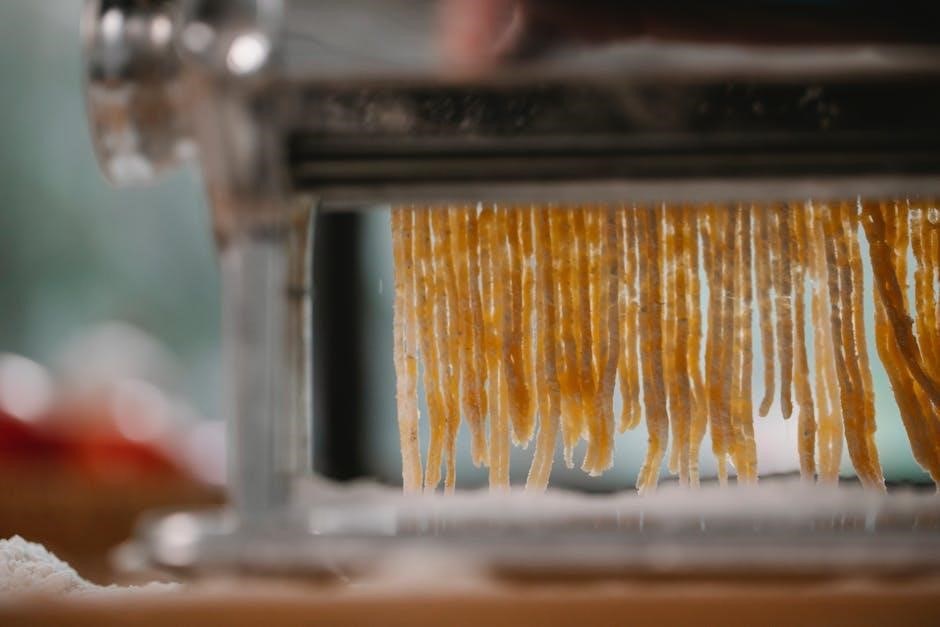Discover the simplicity of creating homemade pasta with the Emeril Pasta Maker․ This guide offers essential recipes and tips to elevate your culinary creativity effortlessly․

Understanding the Emeril Pasta Maker
The Emeril Pasta Maker simplifies homemade pasta creation, allowing users to craft custom shapes and textures with ease, perfect for enhancing culinary skills and creativity․
2․1․ Features of the Emeril Pasta Maker
The Emeril Pasta Maker is designed with user-friendly features, including multiple pasta-shaping discs, adjustable thickness settings, and a durable stainless steel construction․ These features ensure versatility and precision, allowing home cooks to create various pasta shapes like spaghetti and fettuccine with ease․ The machine also comes with a built-in cutter and a comfortable handle for smooth operation․ Additionally, the compact design makes it easy to store, while the included recipe guide provides inspiration for diverse dishes․ Its robust build and intuitive controls make it a valuable addition to any kitchen, catering to both beginners and experienced pasta enthusiasts alike․
2․2․ Benefits of Using the Emeril Pasta Maker
Using the Emeril Pasta Maker offers numerous benefits for home cooks and pasta enthusiasts․ It allows for the creation of fresh, homemade pasta with unmatched texture and flavor․ The machine’s versatility enables users to craft various pasta shapes, from thin spaghetti to wide fettuccine, ensuring customization․ Additionally, it simplifies the pasta-making process, making it accessible to beginners while still appealing to experienced cooks․ The ability to control ingredients ensures healthier and tastier meals․ Its compact and durable design also makes it a practical addition to any kitchen․ Overall, the Emeril Pasta Maker enhances the cooking experience, providing satisfaction and creativity in every homemade pasta dish․
Essential Ingredients for Emeril Pasta Dough
The foundation of great pasta begins with quality ingredients: flour, eggs, and salt․ These components ensure a durable yet pliable dough for perfect pasta creation every time․
3․1․ Flour Mixing Tips
Using the right type of flour is crucial for perfect pasta dough․ Opt for high-quality, fine-milled flour like “00” or all-purpose flour for optimal results․ When mixing, create a mound on a clean surface, forming a well in the center for eggs or water․ Gradually incorporate the flour into the liquid using a fork, ensuring no lumps form․ Avoid overmixing, as it can make the dough tough․ For precise measurements, use a dry measuring cup and level it off with a knife․ This method ensures the dough is evenly textured and pliable for rolling․ Proper flour mixing sets the foundation for smooth, elastic pasta dough, essential for effortless shaping with the Emeril Pasta Maker․
3․2․ Importance of Measuring Ingredients
Accurate measurement of ingredients is vital for achieving the perfect pasta dough consistency․ Using a dry measuring container for flour ensures precise amounts, while liquid measuring containers help maintain the right balance of wet ingredients․ Leveling off measurements prevents excess flour or liquid, which can lead to dough that’s too dense or overly sticky․ Proper proportions guarantee a dough that’s easy to knead and roll, resulting in smooth, even pasta sheets․ Neglecting precise measurements can lead to uneven textures or difficulties in shaping pasta․ Always follow the recipe guidelines to ensure your dough turns out perfectly elastic and ready for the Emeril Pasta Maker․
Step-by-Step Guide to Making Pasta
Start by preparing the dough, then mix and knead until smooth․ Let it rest before rolling it out using the pasta maker for perfect, even sheets․
4․1․ Preparing the Dough
Begin by combining flour, semolina, and salt on a clean, floured surface․ Create a well in the center and add eggs, mixing gently with a fork․ Gradually incorporate the dry ingredients into the eggs until a dough forms․ If the dough feels too dry, add a little water; if too sticky, add more flour․ Knead the dough on a lightly floured surface for about 10 minutes until it becomes smooth and elastic․ Wrap the dough in plastic wrap and let it rest for at least 30 minutes to allow the gluten to relax․ This step ensures the dough will roll out evenly when using the pasta maker․
4․2․ Mixing and Kneading the Dough
Combine flour, semolina, and salt in a mixing bowl․ Add eggs to the center and mix gently with a fork, gradually incorporating the dry ingredients․ If the dough feels too dry, add a little water; if sticky, add more flour․ Transfer to a floured surface and knead for 10 minutes until smooth and elastic․ For a stand mixer, use a dough hook attachment․ Knead until the dough is uniform and slightly shiny․ Avoid overworking to prevent toughness․ Proper kneading ensures the dough will roll out evenly in the pasta maker․ This step is crucial for achieving the right texture and consistency in homemade pasta․
4․3․ Resting the Dough
After mixing and kneading, allow the dough to rest for 1 hour at room temperature, wrapped tightly in plastic wrap or a damp cloth․ This step relaxes the gluten, making the dough easier to roll out thinly and evenly․ Resting ensures the pasta retains its shape and texture during cooking․ For best results, divide the dough into 4 equal portions before resting․ Each portion can be rolled separately, ensuring uniform thickness․ Proper resting prevents the dough from tearing when passed through the pasta maker․ This crucial step enhances the final texture and guarantees a professional finish to your homemade pasta, making it worth the wait․
4․4․ Rolling Out the Dough
Once the dough has rested, divide it into 4 equal portions for easier handling․ Lightly flour each portion to prevent sticking․ Using the Emeril Pasta Maker, start rolling the dough at the thickest setting (1)․ Gradually decrease the thickness with each pass, moving to setting 2, 3, and so on, until reaching your desired thickness (typically 1/16 inch for spaghetti or fettuccine)․ Ensure the dough is evenly rolled and slightly floured to avoid tearing․ If the dough becomes too long, cut it into manageable lengths․ Rolling evenly ensures consistent cooking and a professional finish․ Proper technique guarantees perfect pasta sheets for cutting into various shapes using the pasta maker’s attachments․
Classic Emeril Pasta Recipes
Explore timeless dishes like spaghetti and fettuccine, crafted with the Emeril Pasta Maker․ These recipes highlight fresh, flavorful ingredients and the essence of Emeril’s culinary style․
5․1․ Spaghetti Recipe
Transform your kitchen into an Italian haven with Emeril’s signature spaghetti recipe․ Using the Emeril Pasta Maker, craft fresh spaghetti from a simple dough of flour, eggs, and olive oil․ Roll the dough to your desired thickness and shape it using the spaghetti disc for authentic strands․ Pair with a light garlic butter sauce or a classic tomato sauce․ This recipe is a testament to the Pasta Maker’s versatility and flavor․ Follow Emeril’s tips for the perfect texture and enjoy a dish that feels homemade and satisfying, perfect for a quick yet elegant meal․ Elevate your pasta game with this timeless recipe from Emeril’s collection․ Serve hot and savor the difference of fresh pasta․

5․2․ Fettuccine Recipe
Create rich, velvety fettuccine noodles with the Emeril Pasta Maker․ Combine 2 cups of all-purpose flour, 2 eggs, and a pinch of salt․ Mix until a smooth dough forms, then knead until elastic․ Roll the dough to your desired thickness and cut using the fettuccine disc for wide, flat noodles․ Perfect for creamy sauces, this recipe highlights the Pasta Maker’s ability to craft authentic Italian textures․ Toss with butter, Parmesan, or a decadent Alfredo sauce for a indulgent meal․ Emeril’s fettuccine recipe ensures a fresh, homemade experience that rivals restaurant-quality dishes․ Serve with your favorite toppings and enjoy the satisfaction of a dish made entirely from scratch․

Tips and Tricks for Perfect Pasta
Ensure dough consistency by adjusting flour and water․ Use high-quality ingredients and precise measurements․ Avoid overworking the dough for tender pasta․ Properly clean and maintain your pasta maker․
6․1․ Troubleshooting Common Issues
When using the Emeril Pasta Maker, common issues like dough sticking or uneven thickness can arise․ If dough is too wet, add a little flour․ If too dry, add water gradually․ Ensure the pasta maker is well-dusted with flour to prevent sticking․ For uneven pasta, check roller alignment and adjust thickness settings․ Clean the machine regularly to avoid clogged rollers․ Properly kneaded dough is essential for smooth operation․ Refer to the Emeril Pasta Maker Recipes PDF for detailed troubleshooting guides․ Practice makes perfect, so don’t hesitate to experiment and refine your technique for consistent results․
6․2․ Optimizing Your Pasta Maker
To get the most out of your Emeril Pasta Maker, ensure proper maintenance and usage․ Regularly clean the machine with a dry cloth and avoid using harsh chemicals․ For optimal performance, always use the recommended flour types and measure ingredients accurately․ Experiment with adjustable settings to achieve desired pasta thickness․ Store the machine in a dry place to prevent rust․ Refer to the Emeril Pasta Maker Recipes PDF for detailed tips on machine care and recipe customization․ By following these guidelines, you can enjoy perfectly crafted pasta every time and extend the lifespan of your pasta maker․

Accessing Emeril Pasta Maker Recipes PDF
Access the Emeril Pasta Maker Recipes PDF guide online for detailed instructions, troubleshooting, and a variety of delicious recipes․ Visit the official website for easy download․
7․1․ Finding the Official Recipe Guide
To locate the official Emeril Pasta Maker Recipes PDF, visit the official Emeril Lagasse website or authorized retailers․ The PDF contains detailed recipes, instructions, and troubleshooting tips․ It’s the perfect resource for mastering pasta creation with your Emeril Pasta Maker․